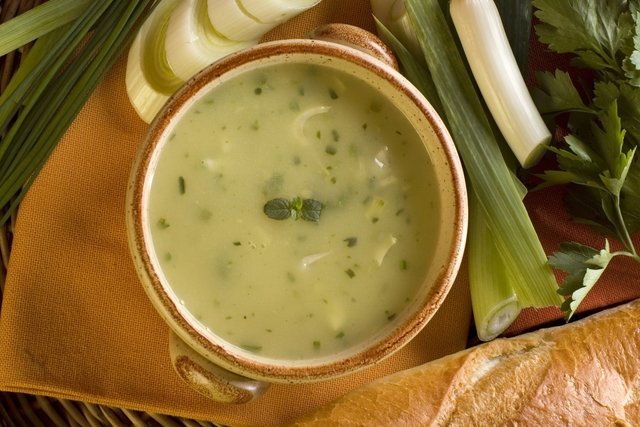A pancreatitis diet for those experiencing an acute flare-up should first be preceded by a few days of fasting to help manage the symptoms of a flare-up. Fasting should then be followed by a liquid diet, made-up of soups, vegetable and meat broths, fruit juices and coconut water.
For chronic pancreatitis, patients should maintain a low-fat diet, avoid alcohol and reduce intake of processed foods. This will help to prevent flare-ups.
A proper diet is essential for treating pancreatitis as it helps relieve the symptoms of this condition, as well as prevent nutrient deficiencies and significant weight loss. However, the diet may vary depending on the type of pancreatitis, and therefore patients are advised to consult a registered before starting the diet.

Diet for acute pancreatitis
The diet for acute pancreatitis should be adhered to in a hospital diet, as it starts by fasting for two days, until symptoms are managed. The doctors may order IV hydration and feeding through GI tubes as needed.
After an acute pancreatitis attack, the registered dietitian may prescribe a liquid diet, consisting of soups, vegetable and meat broths, low-fat blended smoothies, strained fruit juices and coconut water.
As the patient progresses and improves their food toleration, low-fat solid food options can be introduced, such as lean meats, fish and skinless chicken. Vegetables and fruits at this stage should be cooked to facilitate digestion.
Foods to eat
After a pancreatitis flare-up, you should opt for the following foods
- Low-fat dairy products, such as skim milk, skim yogurt and white cheeses
- Easily digestible grains, such as white rice, white pasta and white bread
- Tubers, such as potatoes, particularly in mashed form
- Lean meats, such as eggs, turkey, fish and skinless chicken
- Cooked vegetables, such as pumpkin, chayote, carrots, beets and zucchini
- Cooked fruits, without peels or seeds.
This diet should last for approximately 1 to 2 weeks after the crisis, depending on each person's tolerance and progression.
Foods to avoid
To avoid new pancreatitis flare-ups, you should avoid foods such as:
- Foods that irritate the gut, such as coffee, mint and pepper
- High fat foods, such as red meat, butter, yellow cheeses, biscuits, ice cream and margarine
- Processed meat, such as sausage, bacon, ham, mortadella
- Frozen ready-to-eat meals, hamburgers, lasagna and fast food in general
- Foods rich in sugar, such as cakes, ice cream, puddings and jellies
Furthermore, you should avoid alcoholic drinks, such as beer, wine and liquor.
Diet for chronic pancreatitis
The goals of a chronic pancreatitis diet are to prevent weight loss, stimulate appetite and relieve symptoms such as abdominal pain, nausea, vomiting and diarrhea.
What to eat
Patients with chronic pancreatitis should prioritize the following foods:
- Low-fat dairy products such as skim milk, low-fat yogurt and low-fat cheeses such as cottage and ricotta cheese
- Whole grains, such as brown rice, whole-grain pasta and whole-grain bread
- Lean meats, such as eggs, fish and skinless chicken
- Vegetables, such as okra, jiló, tomatoes, carrots, broccoli, pumpkin and lettuce
- Fruits, such as apple, pear, pineapple, mango, guava, banana and cashew
- Plant-based fats in moderation, such as olive oil, avocado oil and coconut oil
- Herbs and spices, such as pepper, cinnamon, coriander, parsley and chives
- Drinks, such as water, teas and coconut water
Because chronic pancreatitis can lead to poor nutrient absorption, your doctor or dietitian may also prescribe vitamin and mineral supplements.
Food to avoid
Foods that should be avoided when experiencing chronic pancreatitis include:
- High-fat foods, such as red meat, whole milk, butter, yellow cheeses, full-fat yogurt, cookies, ice cream and margarine
- Sausages, bacon, ham, mortadella
- Processed foods, such as hamburgers, pizza, lasagna and fast food
- Foods rich in sugar, such as chocolate, ice cream, cakes and jams
- Ready-made sauces and seasonings, such as mustard, ketchup, mayonnaise and seasonings in sachets or cubes
- Alcoholic drinks, such as beer, whiskey and sparkling wine
It is also essential to avoid large meals, and opting instead for 5 to 6 small meals throughout the day.
3-day meal plan
The following table outlines a 3-day sample meal plan for the pancreatitis diet:
This meal plan is just a sample, as the types of foods may vary depending on the type of pancreatitis (acute vs. chronic) and the patient’s general health status. Therefore, you are advised to consult a registered dietitian to develop a meal plan adapted to your individual health needs.
